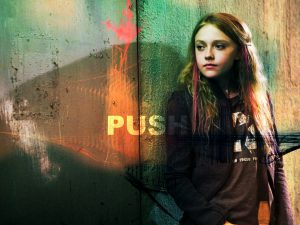
Push (2009), a Hollywood action film set in HK
Question and response
Zhu:
Mr. Chan, I have looked at your profile on IMDB and found out that you have engaged in a lot of transnational filmmaking, where you cooperated with Euro-American directors, playwrights, production teams or film companies. For instance, Push (2009) and Iron Man 3 (2013) are basically Hollywood films with Chinese/HK elements; My Lucky Star (2013) is the work of a US director; Trail of Panda (2009) is produced by the Walter Disney Company. Also quite a few Jackie Chan movie, like Karate Kid (2010) and Rush Hour 2 (2001)……
Chan:
Because I’m old.
Zhu:
Yeah…Oh nonono you’re definitely not old! (Laughter from classmates) As an Art Director/Production Designer, you mentioned that you often take part in determining the overall visual look of films. You also talked about how you created a kind of visual look that is “like Hong Kong and not like Hong Kong” for such “hybrid” films.
I wonder if you can tell us more about the inspirations as well as miscommunication that could result from these transnational cinematic encounters? Particularly, how does such filmmaking affect HK/China/the East as a visual construct on screen?
Chan:
It’s a good question. Actually I already began to work in the local HK film industry in the 90s, (precisely speaking) starting from 94. But later I went to LA to study production design, at the AFI (American Film Institute). I chose to go overseas and study production design because I’m curious about how this career can be studied, since in HK we always learn through working experiences. I was convinced there might be some fundamental knowledge that I should know to become a professional production designer. That’s why I went to AFI. During the time I spent in LA, I went to Universal Studios and all these kind of places, and learned about the way they make movies.
After I came back, the first movie I worked with in Hong Kong was Rush Hour 2. Ever since that, I have worked with lots of the so-called “foreign” movies. Especially in the last 15 years, lots of foreign production teams came to Hong Kong or China to make movies. The thing is, these foreigners don’t really understand Chinese culture. Sometimes they manipulate Chinese culture according to what they think. As we are born and raised in Chinese culture, we have to constantly remind them: No, you cannot do this; No, you cannot do that, this is not what our culture is. We have to drag them back, so as to make the movie look less like a work by foreign production designers. If I need to say no, I’m gonna say no. “No, you can’t make a fish market like that, because an HK fish market is like this.” Or “Yes, you can manipulate the Chinese restaurant like this, but not like what you would imagine in your Chinatown.” So it’s like a back-and-forth process, and I feel like that’s our mission.
Meanwhile, what these foreigners have in mind can sometimes be very different from what we usually see in HK movies. Their ideas can be inspirational and we learn from that. We open our minds. I open my mind when I work with them.
Interviewer’s reflection
As articulated by Mr. Chan above, transnational filmmaking always brings about fresh ideas and cultural misunderstandings simultaneously. Especially in the landscape of global film industry today, where Hollywood is still a hegemonic presence, third-world film artists all carry with them a double mission: to learn from Euro-American films, and also to preserve the uniqueness of their own cultural memory, protecting it from being Orientalized. It is an act of negotiation which is forever ongoing, a “back-and-forth process” as Mr. Chan called it.
Zhu Jieming (UID:3035448524)